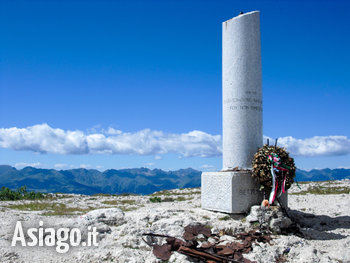The Great War on the Asiago Plateau
Itineraries, forts and museums, events, guided excursions and offers related to the Great War on the Plateau of the Seven Municipalities

The Asiago Plateau and the Great War
The Asiago Plateau, with its history deeply marked by the events of the Great War, was the scene of some of the bloodiest battles fought on the Italian Front. Its territory is now an open-air museum where you can retrace the tragic events of the First World War, visiting forts , museums, war cemeteries and trenches.
Among the symbolic places of this dark historical period, the Asiago Military Memorial stands as an eternal memory of horrors and human sacrifice. Located on the Leiten hill, the memorial, also known as the Leiten Memorial, preserves the remains of over 50,000 fallen, Italian and Austro-Hungarian soldiers, collected from war cemeteries scattered throughout the territory. Built starting in 1932 and completed in 1936 to a design by architect Orfeo Rossato, the shrine impresses with its impressive Roman-style architecture, with a 47-meter-high cubic structure that dominates the surrounding landscape.
In addition to the Memorial, the Plateau of the Seven Municipalities offers the opportunity to explore the places of remembrance through itineraries on the sites of the First World War, routes that touch trenches, forts and museums dedicated to the conflict.
One of the most important and emotional routes is the one that leads to Cima Ortigara, which was one of the bloodiest battlefields and is remembered for the huge losses suffered by both armies involved. This mountain represents a true symbol of the sacrifice of the Alpini in the Great War. The Severed Column of the Alpini, in honour of the fallen and bearing the inscription "Lest we forget", stands up here as a silent and powerful warning. This monument, with its evocative presence, invites reflection on the brutality of war and the courage of those who fought in these mountains. Visiting it means immersing yourself in a story of heroism and sacrifice, for anyone who wants to fully understand the historical importance and emotional value that Cima Ortigara represents for the Asiago Plateau and for all of Italy.
Among the symbols of the Great War on the Asiago Plateau, there are also forts, such as Fort Corbin, the largest and most articulated military fortress in the area. Located in a strategic position overlooking the Val d'Astico, it was one of the main fortifications of the Italian defensive line. Despite being disarmed shortly after the start of the conflict, the fort suffered numerous assaults and was occupied by the Austro-Hungarians during the Strafexpedition of 1916. Restored and maintained by the Panozzo family, who bought it in 1942, Forte Corbin is now completely open to visitors, including the underground, and represents a real open-air museum, offering visitors the opportunity to immerse themselves in history through a visit path marked by arrows and numbers that guarantees to see all the various parts of the fort without leaving anything out.
And again Fort Campolongo in Rotzo, Fort Verena in Roana, Fort Lisser in Enego and Fort Interrotto in Asiago above the town of Camporovere... just to name a few other places related to the events of the Great War on the Plateau.
Another place of enormous historical importance is Monte Cengio, in the municipality of Cogollo del Cengio (VI), at the south-west end of the Plateau of the Seven Municipalities, to whose war history it is closely linked. Here is the spur of rock suspended in the void known as "Salto del Granatiere", a point where, according to the stories, the Grenadiers of Sardinia, left without ammunition, clung to the bodies of the Austro-Hungarian assailants dragging them with them into the precipice during the battle. This place offers not only a deep sense of history but also breathtaking views of the Val d'Astico. The control tunnels , the mule track, the Piazzale dei Granatieri, and the top of Monte Cengio, declared a Sacred Area in 1967 in memory of the approximately 10,000 soldiers who fell here, are elements that contribute to understanding the importance of the place in the Great War.
These places are only a part of the rich cultural and historical heritage of the Plateau, which offers the possibility of understanding the war events that have deeply marked the territory.
On this page you will find a lot of useful information: itineraries on the sites of the First World War, guided tours and excursions, forts and museums and more.
Here you will also find information on where to sleep, where to eat and the offers for stays on the Asiago Plateau, for a complete and enriching travel experience.
All rights reserved.